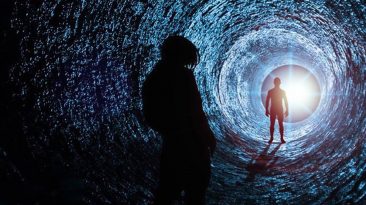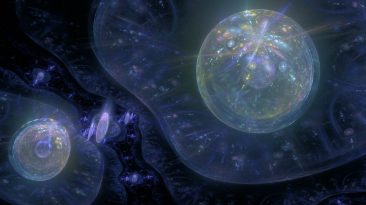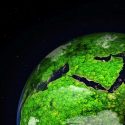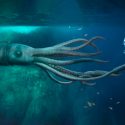One hundred twenty light-years from us, there is an exoplanet that can potentially host life. It’s called K2-18b, and it’s the world you’d want to visit. K2-18b isn’t exactly like Earth. It’s more like a Super-Earth. Yeah, it’s 2.6 times larger and almost nine times more massive than our planet.
Scientists think it could be a Hycean exoplanet. Which is just a fancy way of saying that it likely has a hydrogen-rich atmosphere and is covered in liquid ocean. And that means that K2-18b could be home to alien life. Only it would take a really long time to get there. If you hurtled toward this space rock from Earth, you’d reach your destination in about 1.3 million years. You heard it right, million!
K2-18b orbits a small red dwarf star called K2-18. And it has lots of methane and carbon dioxide in its atmosphere. Which isn’t exactly breathable air, so you’d still need a spacesuit to walk on this world. And I wouldn’t be too hyped up about this ocean, either. If an exoplanet has liquid on it, it doesn’t mean that liquid is water. It could be methane, or ammonia, or even acid. Even in our very own Solar System, there’s a moon covered in liquid lakes. But those are methane and ethane lakes, and I wouldn’t recommend swimming there.
K2-18b could have a pretty mild temperature. For an exoplanet, that is. At -100 °C (-148 °F), you’d find this world incredibly cold. The most exciting thing we’ve found about this world is that it could have traces of dimethyl sulfide. On Earth, this molecule can only be produced by living things. And this means that K2-18b could be home to alien life.
It doesn’t mean that life would be intelligent. It could be aquatic or microbial. Maybe even complex if the conditions for it are just right. We won’t know for sure unless we travel to explore this interstellar world. How do we know all of this? We had the James Webb Space Telescope look at this distant world and take detailed measurements of its atmosphere.
Most of the exoplanets we’ve discovered using what’s called the transit method. It’s when a planet passes in front of its star and blocks its starlight. That’s when scientists study the wavelengths around the planets, and some of those wavelengths can tell us what kind of atmosphere those distant planets have. The problem is exoplanets are really far away. Trying to figure out what their surfaces are like just by peering through even our most powerful telescopes is not easy. Some scientists argue that K2-18b isn’t a Super-Earth at all, but a mini-Neptune. That’s a bummer because, as you know, Neptune is an ice giant. And if K2-18b also is an ice giant, the chances for alien life on this planet wouldn’t look so good.
You don’t have a million years to travel to this world to discover it for yourself. So maybe we should look at a world that’s a lot closer to Earth. Like Proxima Centauri b. Proxima Centauri is the closest star we’ve discovered, only 4.2 light-years away from Earth. It’s part of the Alpha Centauri star system, with not two but three stars orbiting each other. The exoplanet Proxima Centauri b orbits only one of these stars, but you’ll still see the two other stars as bright dots in the sky.
This exoplanet is slightly larger than Earth and revolves uncomfortably close to its host star. Luckily, that star is a red dwarf that’s much cooler and smaller than our Sun. It’s good news because that means this planet isn’t getting toasted like Mercury. Scientists estimate Proxima Centauri b has an average temperature of about -39 °C (-38 °F). That’s pretty comfortable as far as alien worlds go.
The bad news is that we still don’t know much about the exoplanet’s gravity or atmosphere. It might be our best candidate to set up an interstellar base. But it could also have a harsh environment unsuitable for humanity’s future home. It might even have an ocean (pause and then sound dramatic) of acid. Or something deadly like that. The only way to find out is to travel there.
And if Proxima Centauri b doesn’t work out, don’t worry. There are plenty of potentially habitable worlds out there.
Like this one. Ross 128 b. This exoplanet is 11 light-years away from Earth. It’s the second-closest potentially habitable world scientists have discovered. And it’s more promising than Proxima Centauri b.
The thing is, they both orbit red dwarf stars. Only Proxima b’s host star is a lot more active and violent. It occasionally erupts and bathes Proxima b in radiation. Ross 128 b’s star is nice and quiet. And even though this world orbits 20 times closer to its star than Earth is to the Sun, it still lies in the habitable zone. Like I said, red dwarfs are way cooler than the Sun. And by cooler, I mean their temperature.
This world could have a balmy average temperature of 23 °C (73 °F). That’s only slightly hotter than the average temperature on our home planet. I don’t know about you, but I could settle there. Sure, there’s not much we know about this world to call it our new home. It likely has lots of harmful radiation reaching its surface, and its atmosphere might not be breathable. But hey, that doesn’t look much worse than Mars. With efficient life support systems in place, we could make it work.
Besides, this Super-Earth might have its own life on it. If Ross 128 b did have alien life, it could be extremely different from what you could imagine. Just think about making the first contact with an alien species. What could that be like? I mean, it could go very wrong, too. For one, we might not survive the trip to any exoplanets, even the nearest ones. So far, we have discovered and confirmed over 5,000 alien worlds. Sixty-three of them are potentially habitable. But we just can’t know for sure.
Most planets we’ve observed are extremely scary. There is one exoplanet that even looks like Earth. But this beautiful blue world is not the kind of place you could settle on. If you tried, you’d be dead within seconds.



























